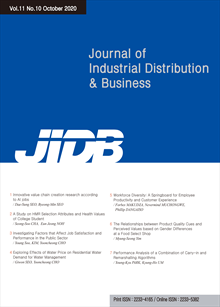간행물
산경연구논집 (JIDB) KCI 등재 산경연구논집 The Journal of Industrial Distribution & Business (JIDB)

- 발행기관 한국유통과학회
- 자료유형 학술지
- 간기 월간
- ISSN 2233-4165 (Print)2233-5382 (Online)
- 수록기간 2010 ~ 2020
- 주제분류 사회과학 > 경영학 사회과학 분류의 다른 간행물
- 십진분류KDC 325DDC 330
권호리스트/논문검색
Vol. 6 No. 4 (2015년 12월) 4건
1.
2015.12
서비스 종료(열람 제한)
Primary Analysis of Information Distribution at Walkbase Company: Developing an Information Strategy
Purpose Currently, organizations – must have a plan to achieve their future objectives. In this case, an information strategy facilitates greater success when planning for the future in any organization.
Research design, data, and methodology – The core objective of the project was to explore the information infrastructure of Walkbase in a discursive manner. We started the project by providing a description of the firm, which facilitates retail outlets using in-store analytical devices.
Results – We conclude that the management of Walkbase revised its current information structure to implement a more structured one that might be included in a long-term investment. On such an occasion, management can prioritize the component to develop first.
Conclusions – Along with our results, we also described the business, its products, its facilities, and how it can serve different industries. Finally, we left the prioritization decision within the framework’s components to top management.
2.
2015.12
서비스 종료(열람 제한)
Purpose This study investigated – the demographic characteristics of retirees who sought not to be reemployed or join an organization but, instead, to be self-employed. This study verified self-employment by regional and/or educational features to determine the self-employment factors and the policies required.
Research design, data, and methodology – Models and hypotheses were used to verify the conversion into self-employment depending on retirees’ demographic characteristics. This study investigated regions according to precedent studies and used SPSS 18.0 as follows. First, frequency was used to investigate the general characteristics. Second, a factor correlation analysis was done.
Results – Hypothesis 1, which stated that, "retirees with low educational background often start a self-employed business," was significant. Hypothesis 2, which stated that, "retirees in metropolitan areas frequently start a self-employed business," was significant. Hypothesis 3, which stated that, "retirees in a megalopolis frequently start a self-employed business," was significant.
Conclusions – A preliminary startup education was needed to lessen the losses. Retirees should have preliminary knowledge of actual self-employment conditions to be given a startup education.
3.
2015.12
서비스 종료(열람 제한)
Purpose To mislead shareholders – about a firm’s actual economic performance, managers frequently manage dividends. Earnings management also affects performance reviews. Managers attempt to manage reported earnings caused by current economic events to accurately reflect their current performance.
Research design, data, and methodology – The sample consisted of 312 company-years from companies in the pharmaceutical distribution industry listed on the Tehran Stock Exchange. A study period from 2004 to 2014 was selected. In this study, a model for measuring the performance of the net profits to total assets of a division of Jones was used to measure earnings management.
Results – This study found a negative correlation between corporate performance and earnings management.
Conclusions – The results for the earnings management company indicated a significant inverse relationship. Therefore, the company’s performance weakened as its earnings management activity increased. In other words, the results showed that the company’s performance-based accruals earnings management, the actual management of profits, and the general level of earnings management had significant inverse relationships. Thus, as the company’s profits declined, earnings management activity increased.
4.
2015.12
서비스 종료(열람 제한)
Purpose This study first explores – the possible dynamic relationship between ownership structure and firm performance using a panel of 4,900 Chinese-listed small- and medium-sized enterprises (SMEs) from 1999 to 2012.
Research design, data, and methodology – We address this issue through a dynamic panel model using a method of moments (GMM) technique and dynamic simultaneous equations to alleviate the potential endogenous problem: unobserved heterogeneity, simultaneity, and dynamic endogeneity.
Results – Under the framework of dynamic endogeneity, firm performance has a significantly positive influence on ownership, but not vice versa. Ownership and performance can be explained by their owned lagged values, respectively. Moreover, intertemporal endogeneity exists among ownership, investment, and performance through the application of system dynamic equations, which implies that the relationship among ownership structure, investment, and firm performance is dynamic by nature.
Conclusions – This study also significantly contributes to a better understanding of dynamic corporate governance by providing further empirical evidence from the largest capital market in the Asian region.

